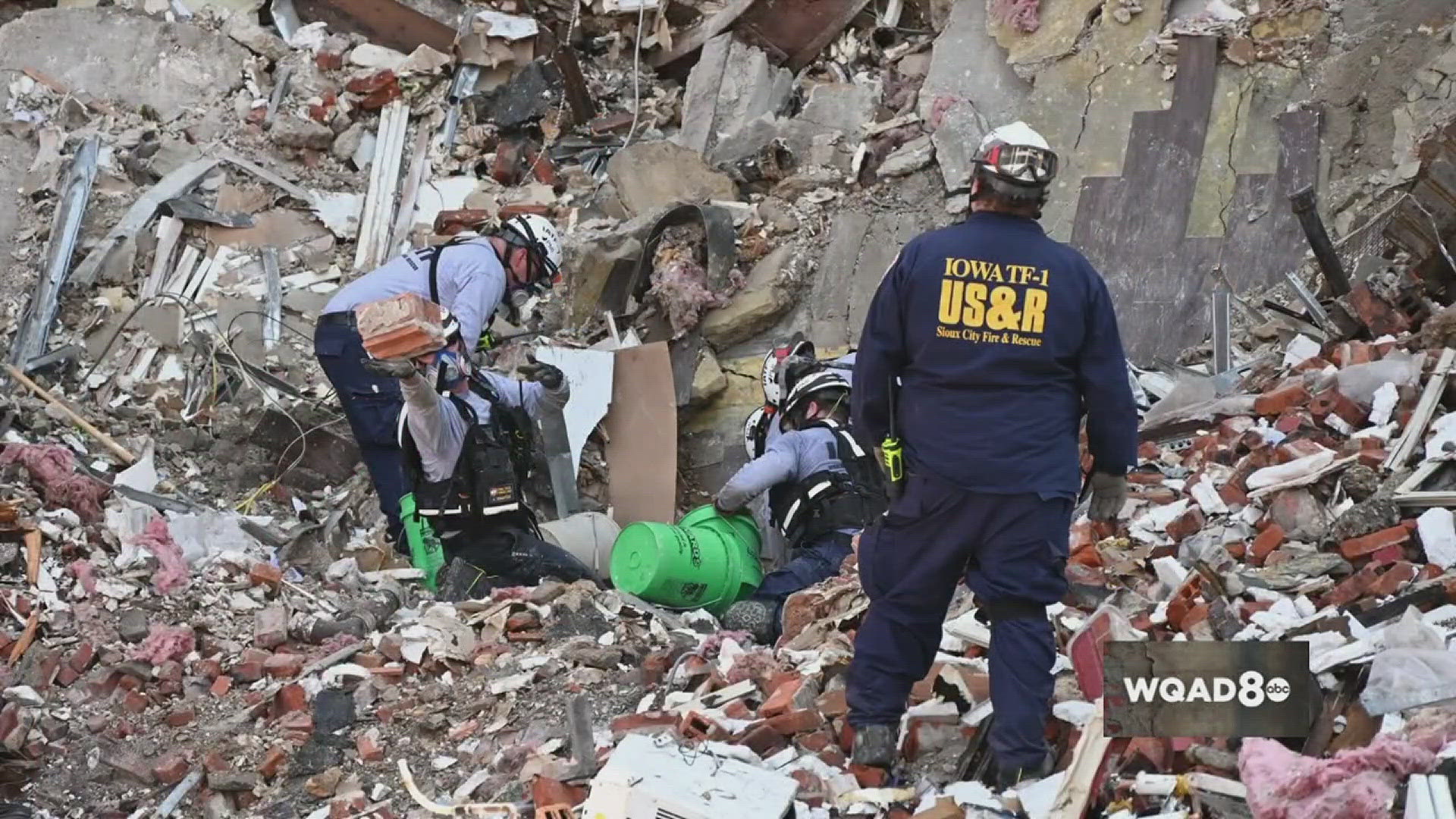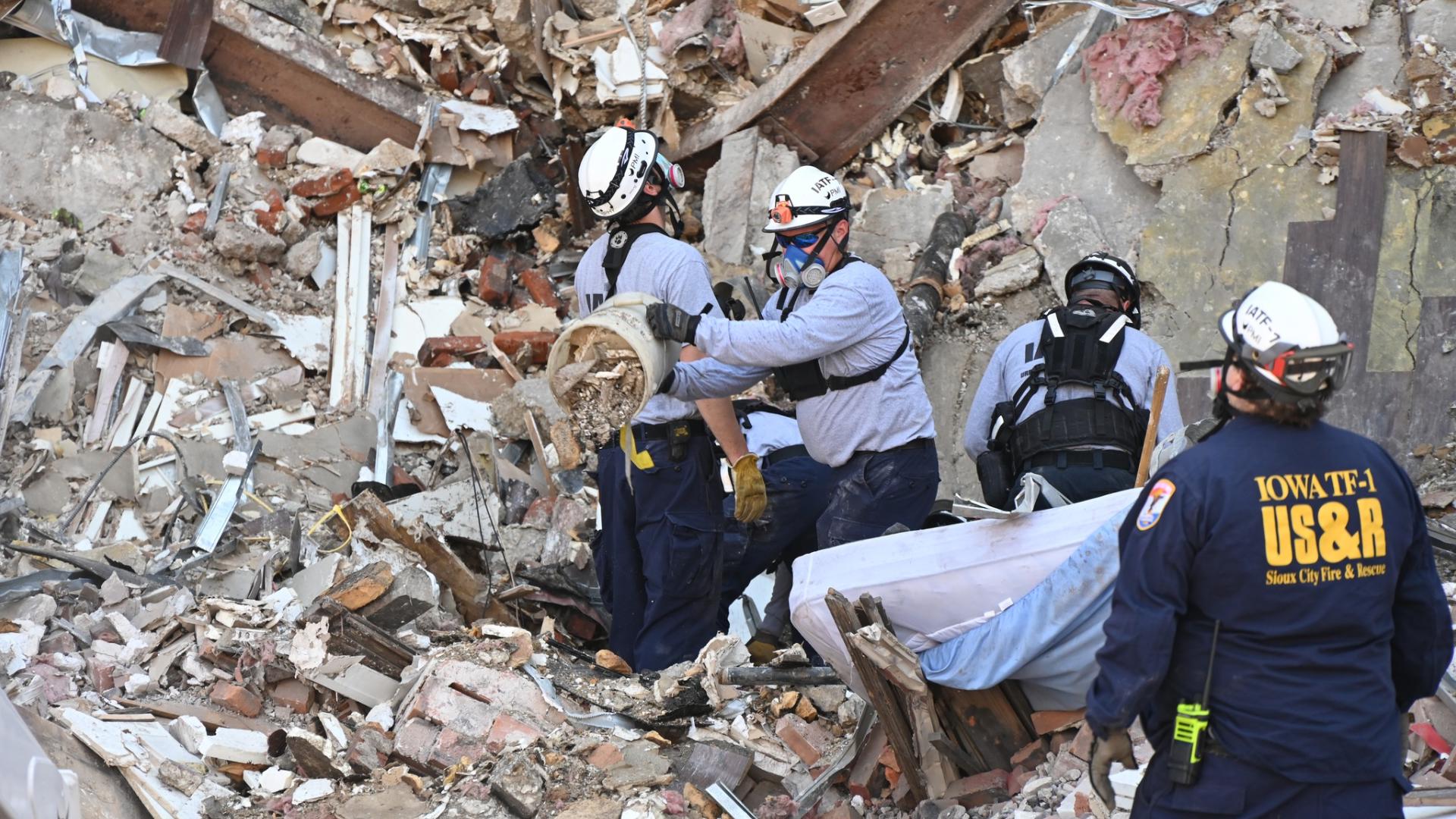DAVENPORT, Iowa — In the hours after 324 Main St. partially collapsed, Iowa Task Force 1 was called to the scene.
Task Force 1 is a specialized group from Cedar Rapids and Sioux City, formed in the early 2000s, and designed to be deployed in emergencies when local departments need support. Around 50 first responders from the team responded to the collapse over the week.
"My wife and I had just gotten to a graduation party of a friend of ours and right when we got there, somebody had texted me, some members on the team, and said, 'Hey, have you heard of what happened in Davenport?'" said Rick Halleran, Task Force 1 US&R chief. "I looked at my phone, I saw the social media and immediately start making phone calls to some of the other command structure members on the team."
Halleran also got a phone call from the Iowa Department of Homeland Security telling the team to stand by as their help might be needed. Task Force 1 arrived in Davenport just before midnight on May 28.
"It was pretty surreal," he said. "You see it on social media and you know it's a big building. You see a large brick building downtown, that report, you don't really understand the size or the scope of it 'til you get on site and then you're standing there beside it."
Task Force 1 wasn't the lead agency but was acting in conjunction with the City of Davenport and other area first responders. Task Force Leader Corey Archer said the first step was establishing that collaboration and trying to gather reports of who might be missing or trapped inside.
"It's just a very, very large problem at that point in time and you're the one that's supposed to fix it," Archer said. "And then doing that structural assessment to make sure like, okay, this building has found its temporary equilibrium. Are we still there? if we start to move, is this going to be a giant game of Jenga, right? We all know how those games end."
Once the structural assessment was done, urban search and rescue teams went in and began searching the building. Archer remembers there was little information available about who was unaccounted for.
"It was a little eerie," Colton Dall said. "Going there, you kind of just try to get a kind of a game plan in your head, kind of just mentally prepare, for once you get there. There was no power to the building, so just was kind of dark, cold, just wasn't a great feeling."
Halleran explained they couldn't send too many people in to search the building at once because it would possibly impose loads the building couldn't handle. They also couldn't just start removing the debris because some of it was holding the building up. He described much of the operation as stop and go.
"Gravity never takes a day off and everything wants to find center of gravity," Halleran said. "Some parts of the building were absolutely untouched. It would look like it would have, you know, a week prior. And then, depending on where you went in the building, the floor started to pitch, the walls started to lean."
Dall remembers trying to enter an apartment, but not being able to get in.
"We put our search cameras in and right below us there was nothing," he said. "The entire apartment was gone. And it was a straight drop into the rubble."
Task Force 1 uses two to three means of search, including their own eyes, canines and tech search. Areas that they had to avoid themselves, the search dogs were sent into or they looked for voids a camera could fit into.
Task Force 1 used both cadaver and life find canines to search for people in the collapsed building.
"It becomes a very detailed mapping process to where they're mapping exactly where that dog is going, what it's seeing, live feed video, sketching to try to identify that if a dog does alert, whether live find or human remains that we can essentially try to pinpoint that or at least narrow that down," Archer said. "Dependent on how that information comes back, we always say we trust, but we have to verify. So there's times where we can get right in there and use tech search. So acoustic listening devices, cameras. If we're not able to confirm that, we still look at that as just a high degree of suspicion, like that's a point of interest for us."
Archer said the dogs alerted for three to six different areas of interest. Changing temperatures, wind and other scents were factors they paid attention to and how it impacted what the dogs could pick up.
In the initial response, Task Force 1 was operating as a search and rescue operation. It wasn't until the team left and came back a few days later the team shifted to a recovery operation, searching for the bodies of Branden Colvin Sr., Ryan Hitchcock and Daniel Prien. Task Force 1 was prepared for the possibility they might not be able to locate someone.
"It was tough," Dall said. "We knew that their families were outside. We just let our training takeover and just kind of accomplish the mission of getting through all that rubble and finding them as quickly as possible."
"You can see it, it's palpable within our technicians that you can see them, not that they're defeated, because now the mission changes," Archer said. "The mission isn't life safety and rescue, now the mission changes to recover that body to provide dignity, provide closure to the family. There's just a small window, but you can, if you know what you're looking for, you can see that shift in them. And then it's 10 minutes later, it's back to business as usual."
The team was using five-gallon buckets and shovels to dig through the rubble. Someone was always looking up at and monitoring the building while the team worked below it.
"If we can find something very particular to the person that's missing, that's fantastic," Halleran said. "But it might just be intel that says the carpet in that apartment is green. So if we find a voice, and we put the camera in there, we find green carpet, we know we're in the right apartment... And then when we would find an item, that would give us a location as to we're in the right spot, or we're not in the right spot. And then we would bring canines back in to keep running over that to make sure that we didn't in the process of going bucket by bucket or hand by hand, we didn't migrate off our point of interest spot."
Task Force 1 found the building didn't collapse and flatten like a pancake. There were voids created. They were able to start piecing together the collapse pattern and see where the apartments had slid.
"Hindsight being 20 20, once we had removed all the victims, we could pretty much almost spot on predict of okay, how that everything transpired to where it's stacked up," Archer said. "And it's like, everything made sense, the puzzle was complete at that point in time."
It wasn't an easy task, especially knowing three people died. In the year since the collapse, Dall said members of the team will check in on one another to make sure everyone is doing okay.
Halleran said part of it is focusing on what they're trained to do and removing their own emotions from it.
"And then you come back, you kind of take a breath, you gather yourself, and then you know, hey, who needs help? Who needs to talk to anybody?" he said.
He's often thought about or been asked if he would have done anything differently in Task Force 1's response. Although more information would have been helpful before the team arrived, Halleran said sometimes they just need to see it for themselves.
"When we ended up finding the last person down there, was if we needed to keep going, what it's going to be needed to bring in another team," he said. "I probably would have started that conversation in my mind a little bit more in sort of prepping and planning with the incident management team that was there. So if we needed to leave and come back, there was no stoppage in the rescue and the recovery efforts."
But he said there's not much he would change about their response. The team's constant training prepared them.
"Looking back, I'm in awe of what we did, what happened, how we did what we could do for the community, the families, the city and everybody involved," Halleran said. "There's lots of things that are done behind the scenes that the crews do, the staff does, to make sure that when we go downrange, we can operate the way we're supposed to and return back the way that we left. And we were fortunate enough to do that working within the shadows of a six-story collapsed building."
__________________________________
News 8 has spent months compiling never-before-seen footage as part of a special report "A Community Rising: Davenport Collapse 1 Year Later." This story is one of many as we commemorate the one-year mark of the tragic event that rocked the Quad Cities community. It would not have been made possible without the hard work and determination of the following WQAD employees: Josh Lamberty, Jon Diaz, Joe McCoy, Jenna Webster, Jonathan Fong, Cesar Sanchez, Shelby Kluver, Scott Weas, Charles Hart, Mikaela Schlueter, Alec Doxsee, Jenny Hipskind, Andy McKay and Corey Spencer.
Find continuing coverage of the Davenport collapse on News 8's YouTube page


